Bioprinting of Tissues and Organs: Materials, Technologies and Perspectives for Regenerative Medicine

This special issue aims to explore tissue and organ bioprinting, examining the latest advances in materials, 3D bioprinting and its applications in regenerative medicine.
3D bioprinting makes it possible to create complex three-dimensional structures from cells and biomaterials, offering new therapies for a multitude of diseases and injuries.
This issue aims to explore and deepen:
- Tissue modelling, highlighting recent advances and future prospects.
- The latest biofabrication technologies, analysing their challenges and opportunities for the manufacture of functional tissues and organs.
- Biocompatible materials, analysing the latest innovations in hydrogels, polymers and ceramics, highlighting their properties and potential for creating different types of tissues and organs.
In short, this special issue provides a comprehensive and up-to-date overview of the application of 3D bioprinting in regenerative medicine.
Electrospun polylactic acid-glycolic acid composite hydrogel scaffold loaded with 3D extracellular vesicles for nasal septal cartilage defect repair
3D bioprinting of biomimetic trachea with interspersed cartilage and vascularized connective tissue for prompt segmental tracheal reconstruction




